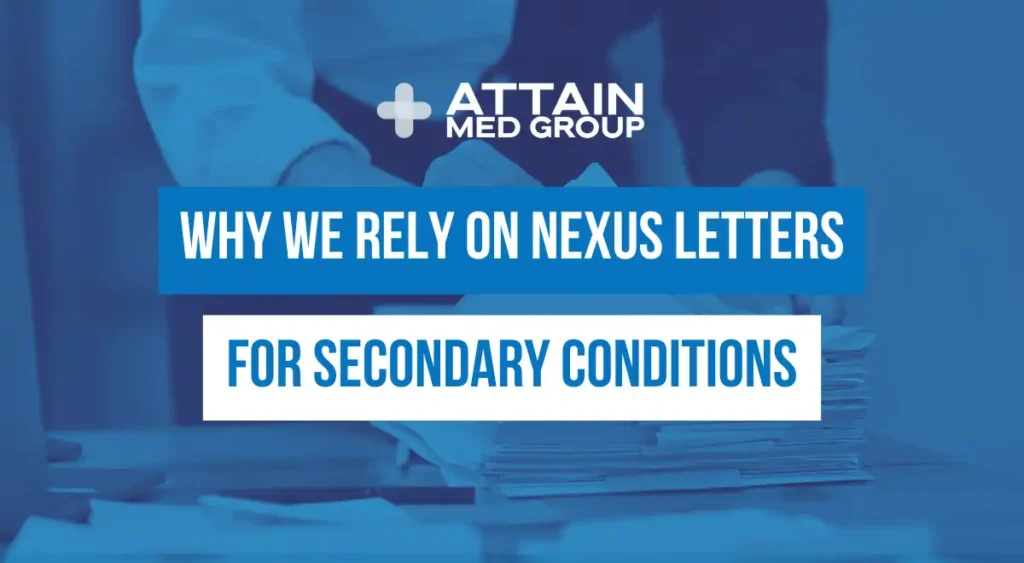Dealing with VA claims can feel like a heavy weight, can’t it? You’ve already proven your primary service-connected condition. But what happens when that condition leads to something else? That’s where secondary conditions come into play, and it’s a big reason Why We Rely on Nexus Letters for Secondary Conditions. It might seem like just another piece of paper, but this letter can be the crucial link the VA needs for your va disability claim. You’re probably wondering how to strengthen your disability claim for these added issues, and that’s precisely Why We Rely on Nexus Letters for Secondary Conditions.
You served your country, and you’re dealing with the aftereffects. It’s only right that you get the support for all related health problems and the va disability benefits you deserve. We understand how frustrating it can be when a new medical condition pops up, clearly tied to your service-connected disability, but the VA needs more than just your assertion. They need that service connection spelled out with clear medical evidence.
Understanding Secondary Service Connection
So, what exactly is a secondary service-connected condition? Think of it like a domino effect. Your primary service-connected disability is the first domino to fall. It then causes or makes another health problem worse – that’s your secondary condition. The VA can grant disability benefits for these secondary issues, but you have to show them the link through convincing nexus evidence. They won’t just take your word for it; the claims process requires proof.
For example, maybe you have a service-connected disability like a knee injury from your military service. Over time, because you’re walking differently to compensate for the pain, you develop a hip problem; this new medical diagnosis could be considered a secondary condition. Or perhaps service-connected PTSD leads to high blood pressure or even sleep apnea. The VA needs medical nexus evidence proving that the PTSD is, at least as likely as not, the cause or aggravation of your high blood pressure or current health issues like sleep apnea. This connection occurs more often than many veterans realize.
It’s important to know that the secondary condition doesn’t have to have started during your military service. It only needs to be medically linked to an existing service-connected disability rated condition. This link is the heart of getting your secondary va claim approved and is essential for establishing secondary service connection.

What Exactly is a Nexus Letter?
A nexus letter is a medical opinion written by a qualified healthcare provider. This letter directly connects your secondary condition to your already service-connected condition. The word “nexus” itself means a connection or link; thus, the nexus letter serves as the medical bridge, providing the medical nexus explaining that connection to the VA. These letters support your va claim significantly.
Who can write one of these important letters? It should be a medical professional familiar with your conditions and medical history. This could be your treating physician, a specialist, or another qualified medical expert. The main point is their ability to review your veteran’s medical records and provide a well-reasoned independent medical opinion on the relationship between your conditions. Sometimes, va doctors may be hesitant or unable to provide such detailed letters for claim purposes, which is why an independent medical opinion can be so valuable.
A strong nexus letter is very clear and uses specific language the VA looks for. It often states that your secondary condition is “at least as likely as not” caused or aggravated by your primary service-connected condition. Vague statements won’t do much good in va disability claims; the letter should explain the doctor’s reasoning, often citing medical principles or even studies if relevant, to support their conclusion for the secondary service link. This clarity is vital for the va claims process.
Why We Rely on Nexus Letters for Secondary Conditions
You might be asking, “Why is this letter so important for my disability claims? Doesn’t the VA do their own exams?” Yes, they often schedule Compensation and Pension (C&P) exams. But the burden of proof is always on you, the veteran, to establish your va disability claim, and relying solely on a C&P exam can be a gamble, which is a major part of Why We Rely on Nexus Letters for Secondary Conditions.
C&P examiners are there to evaluate your current medical condition and its severity. They may or may not spend time deeply exploring the link to another service-connected issue, especially if it’s not immediately obvious or if they aren’t specifically tasked to do so. Their main job is often to assess the severity of the condition rated for examination, not always to establish secondary service connection without clear prompting or pre-existing supporting evidence.
A nexus letter, prepared by a doctor who has reviewed your files and understands your full medical history, directly addresses this connection for your va claims. It gives the VA a clear medical opinion they can use when making their decision on disability claims. This helps to fill any potential gaps in the medical evidence and is a cornerstone of Why We Rely on Nexus Letters for Secondary Conditions when building va disability claims. It offers a professional medical judgment explicitly stating the medical nexus the VA needs to see to approve additional va benefits.
Think about it. A VA rater is looking at your file. They see your service-connected disability like a back problem. They also see you’re now claiming radiculopathy (nerve pain) in your leg as a secondary condition. A well-written nexus letter from a doctor explains exactly how the existing service-connected disability rated back problem is causing the nerve pain, thereby bridging gap between the two conditions. This makes the rater’s job easier and your va claim for secondary service stronger, increasing chances for claim approval.
Common Secondary Conditions and the Role of Nexus Letters
Many health issues can develop because of a primary service-connected condition. Having a medical professional explain this service connection through a nexus letter can make a world of difference in your va disability claim. Let’s look at some common scenarios where nexus evidence is crucial.
Migraines Secondary to Tinnitus or PTSD
Living with constant ringing in your ears (tinnitus), an existing service-connected disability for many, can be incredibly stressful and wearing. This constant auditory irritation can certainly trigger tension headaches or even severe migraines, a new medical diagnosis. Similarly, Post-Traumatic Stress Disorder (PTSD) involves significant stress and physiological arousal, and both can lead to chronic headaches or migraines. Understanding this helps illustrate Why We Rely on Nexus Letters for Secondary Conditions.
A nexus letter in these cases would have a doctor explain the mechanism. For tinnitus, it could be the chronic stress affecting neurological pathways or sleep disruption leading to headaches. For PTSD, it could be related to hyperarousal, elevated cortisol levels, sleep disturbances, or even muscle tension associated with anxiety, all of which are known migraine triggers. This letter spells out what might not be obvious from just looking at a list of diagnoses, providing medical nexus evidence for the disability claim.

Sleep Apnea Secondary to PTSD or Weight Gain
Sleep apnea is a serious medical condition where you stop breathing multiple times during sleep. What if your PTSD, an existing service-connected disability rated at a certain level, keeps you from getting restful sleep, or medications for another service-connected condition cause significant weight gain? Both scenarios can contribute to developing sleep apnea, which becomes one of your current health issues. Many veterans find themselves in this situation, needing to establish secondary service connection.
A nexus letter could detail how PTSD-related hypervigilance and anxiety disrupt normal sleep architecture, predisposing an individual to sleep-disordered breathing. It could also explain how certain medications prescribed for a current service-connected condition (like antidepressants for PTSD or pain medications) are known to cause weight gain, a major risk factor for obstructive sleep apnea. The Department of Veterans Affairs provides information on disability benefits, and understanding these connections with supporting evidence is vital for claim approval.
Depression or Anxiety Secondary to Chronic Pain
Imagine dealing with constant pain from a service-connected disability like a back injury or arthritis. Day in and day out, the pain wears you down. It’s not a stretch to see how this could lead to feelings of depression, anxiety, or general mood disorders as a secondary condition. The mental toll of chronic physical suffering is very real, and a strong nexus letter can highlight this for your va disability claims.
Here, a nexus letter from a psychologist or psychiatrist, or even a primary care healthcare provider, would explain this well-established link. It would describe how the limitations imposed by chronic pain, the loss of ability to do enjoyable activities, the impact on social relationships, and the constant discomfort can directly impact mental health, leading to a clinical medical diagnosis of depression or anxiety. This connection helps the VA understand the full scope of your service-related struggles when they review va claims for secondary conditions.
Radiculopathy Secondary to Back Conditions
If you have a service-connected condition affecting your back, such as a herniated disc or degenerative disc disease, you might start experiencing pain, numbness, or tingling shooting down your leg or into your arm. This is often radiculopathy, a nerve pain medical condition caused by a compressed nerve root in the spine. It’s a very common secondary condition linked to existing service-connected disability rated back issues.
A nexus letter would outline how the specific diagnosed back problem (your primary service-connected issue) is impinging on specific nerves, leading to the radiculopathy symptoms in your veteran’s current state. An orthopedic specialist or neurologist might provide a very strong nexus letter here, perhaps even referencing MRI results or other imaging that shows the nerve compression. This detailed medical rationale is precisely Why We Rely on Nexus Letters for Secondary Conditions, as it provides concrete nexus evidence.
GERD Secondary to PTSD or Medications
Gastroesophageal Reflux Disease (GERD) is another medical condition often seen as a secondary condition in va claims. Chronic stress from PTSD can absolutely wreak havoc on your digestive system, leading to acid reflux. Also, some medications, like NSAIDs frequently prescribed for pain (which might be from another current service-connected issue like arthritis), can irritate the stomach lining and cause or worsen GERD. These current health issues require clear linkage.
A nexus letter from your doctor can explain the physiological pathway. It can show how stress hormones associated with PTSD affect gastric acid production and motility, or how specific medications you take for an existing service-connected disability are known culprits for causing or aggravating GERD. This makes the connection occurs clear for the VA adjudicator reviewing your disability claim for this secondary va issue, highlighting why letters support such va disability claims.

What a Strong Nexus Letter Includes
Not all nexus letters are created equal. A strong nexus letter, one that provides quality nexus evidence, has several key elements that make it persuasive to the VA for disability claims. It’s more than just a doctor saying, “Yes, these are linked.” A medical professional writing such a letter should be aware of these essential elements.
First, the doctor writing the letter must state they have reviewed your pertinent medical records. This includes your service medical records (SMRs), VA medical records, and any private healthcare records relevant to the conditions in question. This demonstrates their medical opinion is informed by your comprehensive medical history. Sometimes, they may even cite specific findings from these records, reinforcing the veteran’s medical background.
Second, the letter should contain a clear and direct statement of the medical opinion regarding the medical nexus. It needs to link the secondary condition to the primary service-connected disability. The magic phrase often cited is that the secondary condition is “at least as likely as not” (a 50% or greater chance) caused or aggravated by the primary condition. Phrases like “is due to” or “was proximately caused by” are even stronger for service connection. Vague language like “could be” or “might be” is too weak and is one of the common pitfalls.
Third, and this is very important, the letter must include the doctor’s medical rationale. Why do they believe these conditions are linked? This rationale should be based on medical principles and an understanding of how the connection occurs. Sometimes, doctors might reference medical literature or established medical knowledge to support their reasoning, although specific citations are not always mandatory if the link is fairly direct and explained well. For instance, explaining how knee instability (an existing service-connected disability rated issue) leads to an altered gait, which then strains the hip causing a new medical condition, is a clear medical rationale for establishing secondary service connection.
Finally, the letter should be signed by the doctor and include their credentials (specialty, license number) and contact information. This establishes their expertise and allows the VA to verify them if needed. A letter from a specialist in the relevant field often carries more weight for complex secondary conditions, but a well-reasoned letter from a primary care physician who knows you well and understands how to articulate the medical nexus evidence can also be very effective in the va claims process.
Here’s a table summarizing these key elements:
| Key Element | Description | Importance for VA Claim |
| Review of Records | Doctor states they’ve reviewed all relevant medical history (service, VA, private). | Shows an informed medical opinion based on comprehensive veteran’s medical data. |
| Clear Medical Opinion | Direct statement linking the secondary condition to the primary service-connected disability, using phrases like “at least as likely as not.” | Provides the explicit medical nexus the VA requires for service connection and to get the condition rated. |
| Detailed Medical Rationale | Explanation of how and why the conditions are linked, based on medical principles or literature. This shows how the connection occurs. | The “because” part; explains the medical nexus logically and scientifically, bridging gap between conditions. |
| Doctor’s Credentials & Signature | Full name, title, specialty, contact information, and signature of the licensed medical professional. | Establishes the author’s expertise and allows for verification; a quality nexus often comes from a qualified source. |
Understanding these essential elements helps providers understand what is needed for a strong nexus letter.
When is a Nexus Letter Most Crucial?
While a nexus letter can strengthen almost any secondary va claim, there are situations where it becomes absolutely crucial for claim approval. If you’re facing these circumstances, getting a solid nexus letter as part of your supporting evidence should be a high priority in your va disability claim strategy.
It’s especially vital when the connection between your primary condition and the secondary one isn’t immediately obvious. For example, the link between a knee injury and subsequent hip pain is fairly straightforward for many to understand. But the link between, say, diabetes (if service-connected) and erectile dysfunction, or between PTSD and irritable bowel syndrome, might need more explicit medical explanation from a healthcare provider for a VA rater to establish secondary connection.
Another critical time is if your initial disability claim for a secondary condition was denied, and the reason given was “no link established” or “no medical nexus.” This tells you exactly what was missing from your va claim. A nexus letter directly addresses that deficiency for a supplemental claim. It provides new and relevant medical nexus evidence that can change the outcome of your va disability claims.
Also, consider a nexus letter if your C&P exam for the secondary condition was unfavorable or inconclusive regarding the link to your current service-connected condition. The C&P examiner might have said they couldn’t establish a service connection or weren’t asked to. Your own independent medical opinion in the form of a nexus letter can counteract that or provide the missing piece of the puzzle. It presents an alternative medical opinion from a qualified medical professional for the VA to consider as they evaluate your current health issues.
Finding a Qualified Professional for Your Nexus Letter
Getting the right healthcare provider to write your nexus letter is a big step in the claims process. Your own treating doctor is often a good first choice, especially if they know your medical history well and are supportive of your va claim. However, not all doctors are familiar with the specific language and requirements of VA nexus letters; some might be hesitant to write them or may not feel they can establish secondary service connection adequately without specific VA knowledge.
If your treating doctor can’t help, you can seek an independent medical opinion from a private healthcare physician. This might be a specialist who deals with your specific secondary conditions. For example, if you’re claiming a heart medical condition secondary to PTSD, a cardiologist could offer a strong nexus opinion. Be prepared to pay for these private opinions, as they typically aren’t covered by insurance for this purpose but are vital for your va disability case.
There are also services and independent medical examiners who specialize in providing medical opinions for veterans’ disability claims. They are very familiar with the VA system and how providers understand the nuances of nexus evidence. However, it’s important to do your research and choose reputable providers. Always verify that any medical professional you use is properly licensed and qualified in their field to ensure a quality nexus letter.
No matter who writes the letter, you’ll need to give them all your relevant medical records. This includes your service treatment records, any VA medical records, and private healthcare medical records related to both the primary service-connected disability and the secondary condition. The more information they have from your veteran’s medical file, the stronger and more accurate their medical opinion will be, aiding your pursuit of va disability benefits for your current health issues.
Potential Pitfalls and How to Avoid Them
Even with a nexus letter, there can be some bumps in the road when navigating va disability claims. Knowing potential common pitfalls can help you avoid them and improve your chances for claim approval. A common issue is a weak or vague letter. If the doctor doesn’t use the specific “at least as likely as not” language for the medical nexus or doesn’t provide a clear medical rationale, the letter might not be very helpful to your va claim. Discuss the VA’s needs with the healthcare provider beforehand.
Another problem can be a letter from a medical professional whose expertise doesn’t quite match the medical condition being claimed. While a general practitioner can write a nexus letter, a letter from a specialist for a complex secondary condition can sometimes be seen as more authoritative by the VA. However, a well-reasoned letter from any qualified physician detailing the service connection is better than none when seeking to have a condition rated.
Make sure you submit the nexus letter correctly with your disability claim; it should be part of your supporting evidence package for your va disability claim. Simply having a letter but not getting it to the VA won’t do any good for your secondary service connection efforts. Keep copies of everything, including all nexus evidence and medical records, for your own records too. The va claims process requires careful documentation.
Finally, remember that a nexus letter is a powerful piece of medical evidence, but it’s still just one piece. Your entire va claim needs to be well-supported to establish secondary service. This includes your personal statements, buddy letters (if applicable), and all medical evidence showing the existence and severity of your secondary conditions and the primary service-connected disability. The nexus letter connects the dots for the secondary service, but the dots themselves (your current medical diagnosis, symptoms, and history) still need to be clearly established. The goal is for veterans receive the benefits they are entitled to.

Conclusion
Filing for secondary conditions as part of your VA disability claims can feel overwhelming—but you don’t have to go it alone. Understanding Why We Rely on Nexus Letters for Secondary Conditions is a critical step in building a stronger, more successful claim. These medical opinions act as the bridge, connecting your current health issues to an existing service-connected condition with the clear, clinical explanation the VA needs to see.
A well-crafted nexus letter from a qualified medical professional can truly be the difference between approval and denial. It provides the vital medical nexus evidence that explains how your primary condition has directly caused or aggravated your secondary condition—helping you secure the full VA disability benefits you’ve earned through your service.
If you’re ready to strengthen your claim with the right medical support, contact Attain Med Group. We provide veterans with expert Nexus Letters and medical documentation tailored to meet VA standards for secondary service connection claims.

